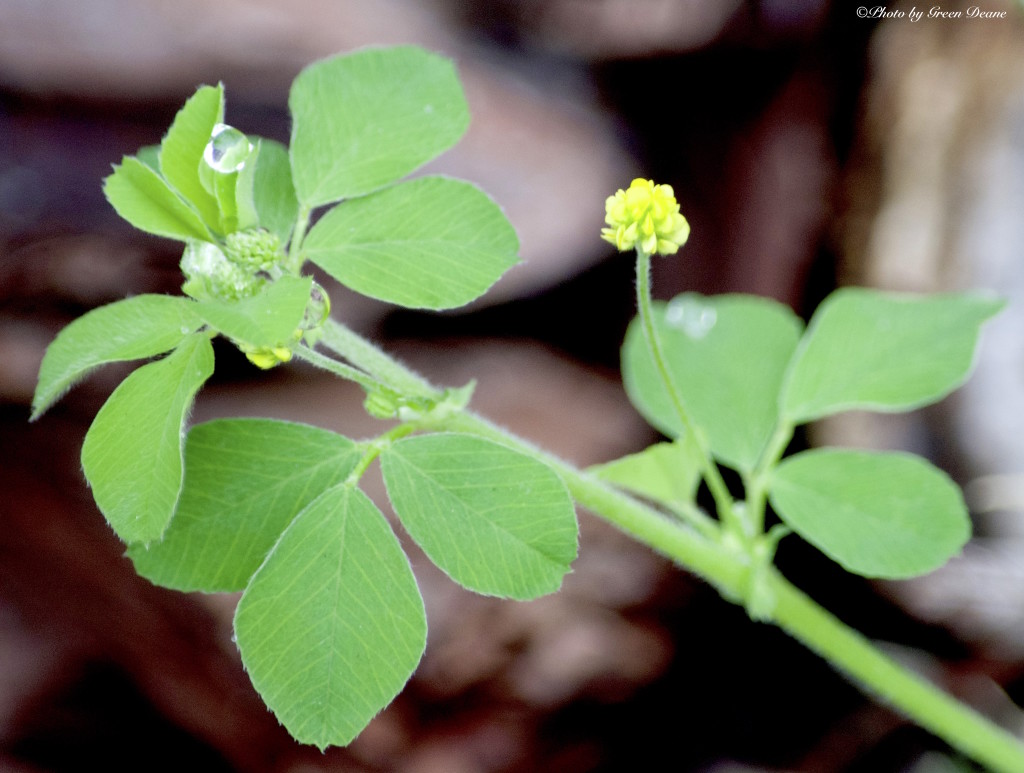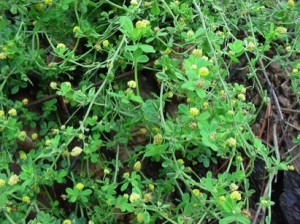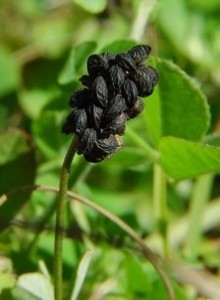Medicago Lupulina: Grain and Potherb
I debated a long time whether to include Black Medic as an edible. There are several plants in that category and over time I usually land on one side or the other. Black Medic is one of them.
Black Medic itself has not been implicated in any disease that I currently know of. But one of its relatives and at least one chemical it contains has. Not exactly a smoking gun but where there is warmth there might be fire.
Black Medic is a species in the Medicago genus. Some Medicagos (Alfalfa for example) might present a health risk because they have L-canavanine. It’s an amino acid which can cause abnormal blood cell counts, spleen enlargements, or a recurrence of lupus in those who had the disease under control. Seeds and sprouts have more L-canavanine than leaves or roots. One qualifier: Heated alfalfa did not appear to cause any problems, and the thinking is heating the L-canavanine destroys its potential toxic activity. The seeds of the Black Medic might also contain trypsin inhibitors that could reduce nutritional qualities. Sprouting the seeds might eliminate that purported problem. It’s all rather iffy.
Alfalfa also has some estrogenic components, so it is not recommended for pregnant women or children, and it also increases the clotting ability of your blood, or decreases the effectiveness of such drugs as Warfarin/Coumadin. Lastly Alfalfa sprouts can appear fresh yet contain a multitude of bacteria so they are not recommended for children, those with chronic disease, or the elderly. It would seem cooking the Medicago genus is a good idea. So, if you are a healthy young man you might be able to eat a Medicago now and then and be none the worse for it. But what about Black Medic? The answer is no one really knows.
A report that California Indians used to eat the seeds of the Black Medic is a curious one. They parched them or ground them into a flour. The seeds can be beaten off ripe inflorescences over a sheet or the like to collect them. In Eurasia, where the plant is native, it was used as a potherb. Black Medic is first mentioned in the early United States in a seed catalog in Pennsylvania in 1807. The plant went west with the expansion of the nation. Oddly there seems to be no mention of the Indians eating it as a potherb (they only ate the seeds) nor any mention of Eurasians eating the seeds (they only ate the foliage.) Need could dictate that, poor record keeping, wrong questions asked, or how the plant was being used the day the chronicler visited.
According to the well-known Dr. James Duke (Medicinal Plants of China) nutritionally the leaves of the Black Medic are rather high in protein for a green. Three ounces has about 23.3 grams of protein, 3.3 of fiber and 10.3 of ash. In milligrams they have 1330 mg of calcium, 300 mg of Phosphorus, 450 mg of magnesium and 2280 mg of potassium.
Botanically the Black Medic is Medicago lupulina. Medicago (med-ik-KAY-goh) is Greek bastardized through Dead Latin. Some say the Greeks imported a grass (alfalfa) from Media (Persia now Iran.) Some say the Medes brought it with them when they invaded Greece. Regardless the Greeks called it “median grass” which in Greek is μηδική (said mee-thee-KEE.) The Romans’ called it Medica. That got botanized into Medicago when combined with agere, to bring.
Lupulina is Latin for “little wolf. Origin of the term is a bit contorted. The Black Medic blossom resembles Hops (Humulus lupulus which means “low wolf.” That hops in Germany often climbed on the Willow Wolf Tree, Lupus silicarius (wolf with silica.) That double hint towards lupus ended up Lupulina.
Green Deane’s “Itemized” Plant Profile: Black Medic
IDENTIFICATION: Medicago lupulina: Multi-branched, slender, prostrate, slightly hairy stems, 12 to 24 inches long, spreads low to the ground, does not root from nodes. Leaflets of three, center leaflet on separate petiole and longer than other two. Resembles hop clover but has longer leafstalk, leaflets often bristle-tipped. Tightly coiled one-seed black pod. Re Black Medic and Hop Clover: Stems of M. lupulina are downy (they have white hairs.) The stems of Trifolium. dubium are almost hairless and more reddish.
TIME OF YEAR: Flowers April to August, seeds ripen July to September. Not frost tender.
ENVIRONMENT: Roadsides, waste areas.
METHOD OF PREPARATION: Seeds parched and or ground into flower. Leaves as a potherb. Chewy. Should be cooked.





Hi! Thanks so much for this. I have both black medic and burr clover in my yard. I am trying to pull it out and get rid of it because of the burrs (black medic doesn’t have them…but it looks so much like burr clovers I can’t tell them apart until they actually have gone to seed, and then it’s too late to pull them). Was wondering if I could eat any of the greens on all this “clover” I was removing. Another site said you could eat the burr clover, but if the black medic is iffy I’ll probably just let it go.
I don’t have a reference that says hop clover (Trifolium campestre) is edible.
So there is no truth to the comment that Black Medic is a cause of recurrence of Lupus, right? Glad to know that was a little far-fetched. Thanks for the warning to be sure to cook the plant before eating it. It doesn’t sound as though it is very medicinal.
Alfalfa is rich in vitamin K, which is why it reportedly assists blood clotting and might be iffy with coumadin. But let’s keep in mind that vitamin K is an essential nutrient, and also plays a role in connective tissue production, bone density, and calcium metabolism. If black medic is rich in vitamin K I would count that as a good thing, and simply balance its blood clotting effects with blood thinning nutrients like vitamin E, sulfur, and omega 3s, for example. Sounds like a light saute of this plant would be perfectly nutritious and safe.
do you eat black medic personally? because the article seems to sway against it?
It’s interesting to me that you say alfalfa is not recommended for pregnant women, because it’s in every pregnancy tea I’ve ever seen. (The most common “core” of an herbal tea for pregnancy is “NORA” — nettle, oatstraw, red raspberry leaf, and alfalfa.)
I think eating small amounts may be good. I ovcasionaly add seeds in my oatmeal. Most things shouldnt be eaten in large quanities anyhow. Ive never eaten the greens.
I haven’t been able to find out if the use of the seeds refers to the dried black ones or the softer greenish ones. The black ones seem too hard to be eaten and enjoyed out of hand. They don’t taste that great, either. I lightly toasted the green ones. They were much more palatable and actually tasted salty. I wouldn’t call them delicious, though. Any thoughts on whether it’s the green or black seeds that get referred to?
…Most of what Ive read involves grinding the seeds after drying, and then soaking them in water to produce a paste…They are high starch, so this seems more correct. In other medic varieties, such as the ones in the Mediterranean basin, they say the same thing, its just more to do with making alcohol, with the flour secondary. The same single flowered burr clovers are used medicinally for rheumatism and topically, I imagen with something like plantain, self heal, pine/conifer (resin and inner bark) or capsaicin in a balm with processed animal fat, bees wax and plant waxes or oils, olive for example is drawing so would pull any infections to the surface or into the blood from tissues when heated, for removal from the body, topically in a balm this would work with the substances/vitamins in burr clovers. All the articles say to cook the tender greens, like spinach. I have eaten the single flower type greens cooked and raw as a kid, I was very healthy and rarely became sick, high IQ etc, but I also didn’t have any collagen disorders so this may make a large difference, so maybe those peoples should stick to topical use…
Can these weeds be used in Vermiposting?
Did some research on trypsin inhibitors. If you heat the offender up, it substantially reduces the amount of trypsin in it. Fresh green soybeans are boiled for 9 minutes to inactivate the trypsin inhibitors. I don’t think that’s completely necessary for medick, primarily because medick most likely won’t be a huge source of nutrients in the first place for many diets. Not to mention, humans are much more resistant to the effects of trypsin than other mammals. But boiling would decrease trypsin, for those individuals that are worried.
So I just did some more research. Turns out that the roots of black medick, and alfalfa plants in general, are high in medicagenic acid and its derivatives, which is a saponin that has major antifungal/antimycotic activity. So much so, that there were multiple studies done to show the efficacy of its properties on potential hazards that are the consequence of utilizing immunosuppressive drugs in transplant patients, cytotoxic chemotherapy, broad spectrum antibiotics, cryptococcosis which occurs commonly with AIDS patient, and previous agricultural niche saprophyte fungi that are relatively resistant to conventional therapies.
The saponin extracts used were of dried alfalfa roots. But did include the metacagenic acid derivative found in black medick.
NO Native Americans ate these seeds in ANY form… They were introduced by Europeans and never existed here before that time… Thjey are an invasive plant that needs to be eradicated outside the Mediterranean where they originated…
While I agree they are not native to North America and not an American Native food per se. However, there were being consumed by them in the Depression according to a survey then which is why some erroneously list them as a native American food.